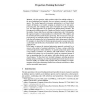Free Online Productivity Tools
i2Speak
i2Symbol
i2OCR
iTex2Img
iWeb2Print
iWeb2Shot
i2Type
iPdf2Split
iPdf2Merge
i2Bopomofo
i2Arabic
i2Style
i2Image
i2PDF
iLatex2Rtf
Sci2ools
113
Voted
EDBT
2004
ACM
2004
ACM
Projection Pushing Revisited
The join operation, which combines tuples from multiple relations, is the most fundamental and, typically, the most expensive operation in database queries. The standard approach to join-query optimization is cost based, which requires developing a cost model, assigning an estimated cost to each queryprocessing plan, and searching in the space of all plans for a plan of minimal cost. Two other approaches can be found in the database-theory literature. The first approach, initially proposed by Chandra and Merlin, focused on minimizing the number of joins rather then on selecting an optimal join order. Unfortunately, this approach requires a homomorphism test, which itself is NP-complete, and has not been pursued in practical query processing. The second, more recent, approach focuses on structural properties of the query in order to find a project-join order that will minimize the size of intermediate results during query evaluation. For example, it is known that for Boolean project-joi...
Related Content
| Added | 08 Dec 2009 |
| Updated | 08 Dec 2009 |
| Type | Conference |
| Year | 2004 |
| Where | EDBT |
| Authors | Benjamin J. McMahan, Guoqiang Pan, Patrick Porter, Moshe Y. Vardi |
Comments (0)

